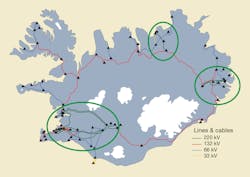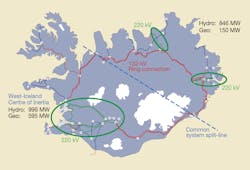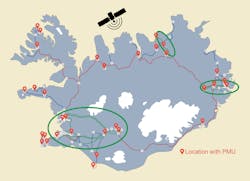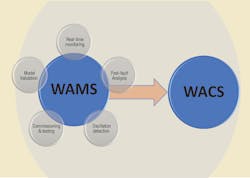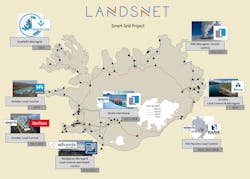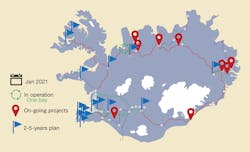Wide Area Monitoring and Control Come To Iceland
Landsnet operates the transmission system of Iceland, which sits in the middle of the Atlantic Ocean with no interconnections. The islanded transmission system consists of 3270 km (2032 miles) of overhead lines and 243 km (186 miles) of underground cable linked to 75 substations. It also contains three 220-kV cable sections in areas with the largest generation and concentrated load centers. These three geographical regions are connected to the long and weak 132-kV transmission system, which forms a ring around the perimeter of the island.
The installed generation is 100% renewable, dominated by hydro plants supported by approximately 25% geothermal power. The peak load demand on transmission is now about 2400 MW, of which 80% of generation is supplied to power-intensive commercial and industrial customers. During the last two decades, the installed generation capacity has more than doubled. However, Landsnet has not been able to reinforce its connections between the three centers because of environmental reasons, as well as the visual impact that additional overhead transmission lines would have on the landscape.
To prevent potential reliability issues, the utility started examining the benefits of a wide area monitoring system (WAMS) in 2006. This pilot project was in parallel with the construction of 220-kV overhead lines in East Iceland, which was part of a major project to build the largest hydro plant (the 690-MW Kárahnjúkavirkjun plant) and the largest aluminum smelter — the largest load unit is around one-quarter of all the connected load, producing 346,000 tons per year at Alcoa Fjarðarál — in the country. The utility experienced significant improvement in stability and damping in the system, which was measurable in the WAMS. In turn, its use of the WAMS has expanded.
System Performance
Landsnet’s transmission system often is subjected to extreme frequency fluctuations. While mostly stemming from the tripping of large power-intensive loads relative to system capacity, the fluctuations also are a result of unforeseen events in the largest power plants connected to the transmission system and fault disturbances on the overhead lines. These events can overload the 132-kV ring connections, which often result in system-split and islanding operation, thus increasing the utility’s risk of cascading events and blackouts.
Power oscillations — or the swinging of active power back and forth over long transmission lines as a result of weak coupling — between the east and west sections occasionally makes the transmission system unstable, resulting in islanding events. Power generating producers also have increased pressure on Landsnet in recent years to provide larger load transfer capacity between regions, to optimize the utilization of water reservoirs. This need has made it more challenging for the transmission system operator (TSO) to maintain reliability of a system already operating close to the thermal and transient limits, thereby making it more vulnerable to disturbances.
Pilot Project
These potential issues are what led Landsnet to start examining the potential benefits of WAMS in 2006. During that time, the utility was experiencing some inexplicable operation issues with instability in the power and voltage in the system, which was difficult to monitor and analyze with a conventional supervisory control and data acquisition (SCADA) system, as the sampling frequency was one sample every 3 seconds to 5 seconds at best.
The first phasor measurement units (PMUs) were installed, which gave 50 samples per second with a time-stamped global positioning system (GPS) measurement streamed over the communication network to the WAMS installed at Landsnet headquarters in Reykjavík. This new data revealed how dynamic the system could be, something the utility had not experienced before. At first, information from the PMUs was used offline to analyze and tune power system stabilizers (PSS) at power plants around the ring connection. The utility saw significant improvement in stability and damping in the system, which was measurable in the WAMS.
Realizing the potential of this technology, Landsnet installed additional PMUs around the transmission system. The utility also implemented WAMS in its control room, which was an eye-opener for real-time monitoring and operation of the grid. Operators received training, which helped to improve their awareness of oscillations and other operational issues in the system. This deeper understanding has led to more efficient work processes and mitigation actions.
The WAMS also enhanced the utility’s post-fault analysis. It provides a detailed sequence of events during a disturbance, which complements SCADA alarms and disturbance recordings from relays. The commissioning and testing of all new equipment connected to the transmission system has been augmented so any undesirable response to events is detected.
WAMS data has been a great source of infor-mation for model validation, such as for compar-ison with dynamic grid simulation models. In
addition, a recent master thesis project to develop an automatic disturbance reporting tool based on WAMS data, using machine learning for event analysis and categorization, has been completed successfully.
Wide Area Monitoring
The e-terra PhasorPoint WAMS from GE Digital started as a stand-alone system installation at Landsnet. As the importance of the system grew over time, it required an updated infrastructure. It is now integrated with GE’s SCADA energy management system (EMS) platform, which makes the WAMS part of a redundant, secure and reliable software architecture.
Landsnet continues to use multiple vendors for its PMUs, network equipment and other control equipment in the field. All new and refurbished substations are required to have either a stand-alone PMU or an integrated PMU function within intelligent electronic devices (IEDs), like bay control and protective relays.
The WAMS data also offers a great possibility to be used in real-time automation and control applications. Landsnet has been one of the early adopters in using this aspect of the wide area technology. In 2016, it formed a smart grid development group to focus on implementation of wide area control schemes (WACs), in other words system integrity protection schemes.
Wide Area Control Schemes
WACS make use of synchrophasor-based signals from the PMUs as inputs into control units (Landsnet uses GE’s PhasorController), which run logic and control algorithms to determine, in the case of a disturbance, whether it is beneficial to trigger fast controllable resources. Landsnet has implemented the following resources:
- Fast control of thyristor-controlled aluminum smelter loads
- Fast ramp of hydro and geothermal plants
- Load shedding
- Micro grids with controlled islanding.
The key objectives of the WACS are to increase system security, reduce frequency deviation, and minimize the probability and impact of disturbances in the transmission system.
The initial control schemes were relatively simple, mainly using regional frequency and power flow measurements with thresholds for triggering a response. Landsnet and GE worked together on the EU Horizon 2020 MIGRATE project to develop the next generation of WACS, to prove this technology for other TSOs faced with the challenge of increased penetration of renewable energy sources and lower system inertia. The new generation of WACS makes use of the regional inertia levels — where the corresponding region has measurable or estimated inertia that tells Landsnet how fast the frequency will change when there has been a shift in power imbalance (generation vs. load) — the rate of change of frequency (RoCoF), locational detection and regional power imbalance to provide the most optimal control response for mitigating disturbances.
The WACS can trigger a response around 300 msec after an event occurs, whereas 100 msec is the fixed communication latency in current network infrastructure. The improvements in system operation with the addition of WACS is undeniable when disturbances are subject to post-event review and analysis. However, it has proven more difficult to establish a clear benefit simply by looking at overall disturbance statistics over longer periods of time.
Based on a comparison of near-identical disturbance events before and after the implementation of WACS, the maximum frequency deviation has been reduced by 16%. It also has been estimated between 30% to 40% of all recorded system disturbances would have caused overloading of the ring-connected 132-kV transmission system and, therefore, islanding prior to installing WACS.
Digital Development
Landsnet also is now focusing on digital development and has made an ambitious decision that all new and refurbished substations shall be made fully digital, based on IEC 61850. The utility already has implemented local smart grid schemes incorporating IEC61850 generic object-oriented substation events (GOOSE) from protection relays and WACS GOOSE control signals. Its transition to a digital substation will further raise the requirement for inter-substation communication. Therefore, making the most out of what IEC 61850 control and protection offers will extend the possibilities for smart grid development, improving flexibility for the transmission system as well as customers.
Landsnet will continue engaging in digital development and seeking ways to deploy smart grid solutions, as they have proven to be effective in terms of transmission system operation and cost compared to other investments (for example, battery storage and synchronous condensers). The utility’s objective has been to make use of resources already connected to the transmission system, thereby maximizing the use of the assets with the help of the latest control and communication technologies.
Projects to achieve this objective have been deployed with operational support in mind, without having the compensation market in place. Landsnet has ongoing work to develop a new ancillary service and settlement format for such fast frequency response providers, to increase the available volume of response and further improve the overall stability and reliability of the transmission system. This service will apply to both the production and demand sides.
Numerous ideas are on the drawing board for future WACS. For example, with an increased number of data centers in Iceland, new load control ideas are being investigated. Wide area oscillation and instability detection also is one of the topics being explored, as it could be of great value in mitigating the stability issue along the 132-kV ring connection coupling the centers of inertia. The future is green, electric and full of opportunities for Landsnet and other utilities engaging in this digital transition.
System Visibility
The introduction of WAMS was an eye-opener for Landsnet. For the first time, the utility could see detailed information about stability issues in the system dynamically. The WAMS quickly became a fundamental tool to monitor and operate the transmission system. It also enabled Landsnet to refine processes and determine mitigation actions for improving the stability and security of the system. This success has led the utility to expand its use of wide area technology beyond monitoring. Now it is using the technology to design and implement WACS for automated responses to mitigate the effects of disturbances. When system operators at Landsnet were asked what it was like to operate the transmission system prior to having the WAMS, they described it as driving a car in the dark without headlights.
Acknowledgement
The author wishes to acknowledge the technical support and advice given in preparation of this article by Ragnar Guðmannsson of Landsnet and Douglas Wilson of GE Digital. Also, Landsnet and the author wish to express their thanks to the large power customers Norðurál, Rio Tinto ISAL, Alcoa Fjarðarál and Landsvirkjun for their willingness to participate in the WACS trials.
Birkir Heimisson ([email protected]) has a BSEE degree from University of Iceland in 2011 and a master’s degree in electric power engineering from Chalmers University in 2014. He joined Landsnet as a system operator in 2014. Together with system operations, he has led smart grid development with a focus on wide area measurements and control. Additionally, Heimisson was the work-package leader for Landsnet in the EU Horizon 2020 MIGRATE project. In 2019, he moved to research and development, where he focuses on digital substation implementation and smart grid development.
For More Information
GE Digital | https://www.ge.com/digital/applications/transmission
IEC | https://www.iec.ch/understanding-standards
About the Author
Birkir Heimisson
Birkir Heimisson has a BSEE degree from University of Iceland in 2011 and a master’s degree in electric power engineering from Chalmers University in 2014. He joined Landsnet as a system operator in 2014. Together with system operations, he has led smart grid development with a focus on wide area measurements and control. Additionally, Heimisson was the work-package leader for Landsnet in the EU Horizon 2020 MIGRATE project. In 2019, he moved to research and development, where he focuses on digital substation implementation and smart grid development.

